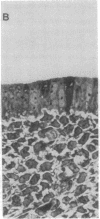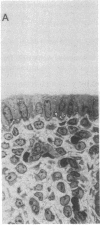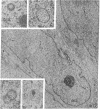Abstract
The effects of estradiol and nafoxidine on nuclear estrogen receptor binding, RNA polymerase activities, and uterine ultrastructure were studied. Animals were either injected with estradiol, implanted with estradiol/paraffin pellets, or injected with nafoxidine. Animals treated with nafoxidine or estradiol implants showed sustained long-term nuclear retention of estrogen receptor and increased nuclear RNA polymerase activities for up to 72 hr. A single injection of estradiol caused initial increases in these variables which returned to control levels by 24 hr after hormone treatment. Uterine tissue was examined by light and electron microscopy 72 hr after hormone treatments. Uteri from eith estradiol-implanted or nafoxidine-treated animals showed markedly increased hypertrophy of the luminal epithelial cells. Nuclei in sections of the uteri of these hyperestrogenized animals displayed a large number and wide array of nuclear bodies composed of a filamentous capsule and granular cores. We conclude that hyperestrogenization, a condition that eventually results in abnormal cell growth, is correlated with increased and sustained nuclear binding of the estrogen receptor, increased and sustained RNA polymerase activity, and the appearance of nuclear bodies.
Full text
PDF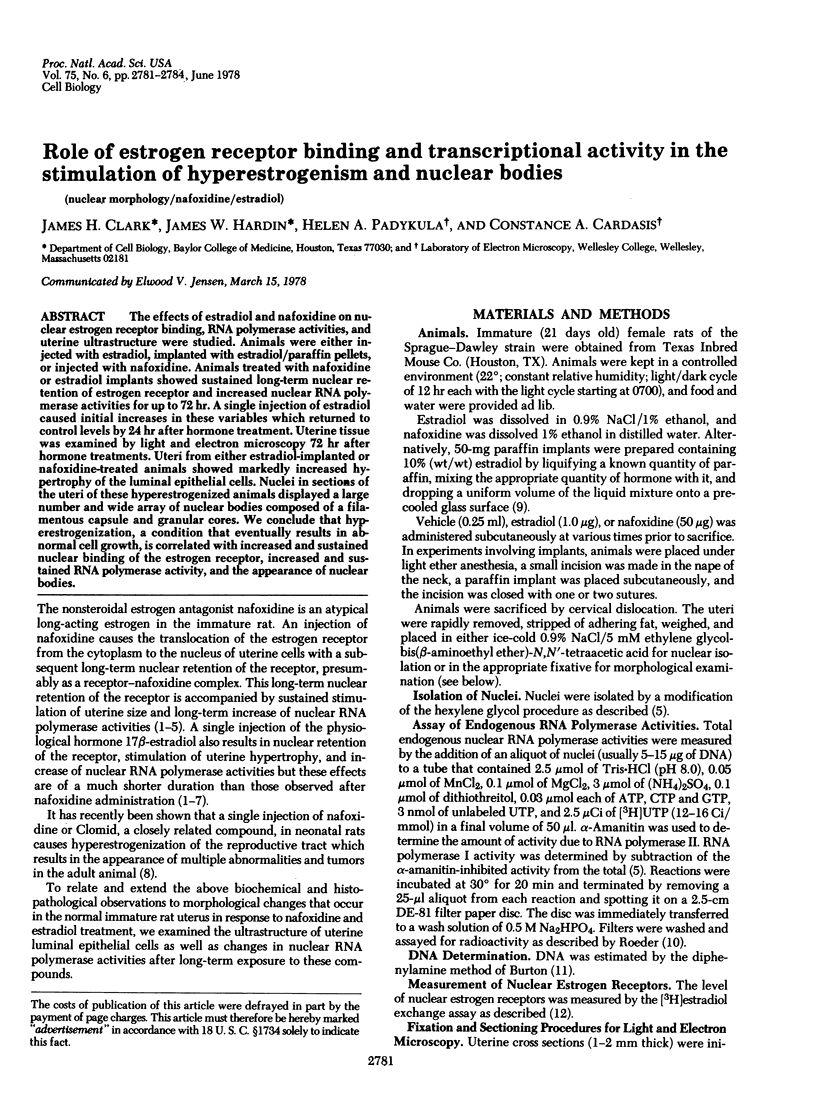
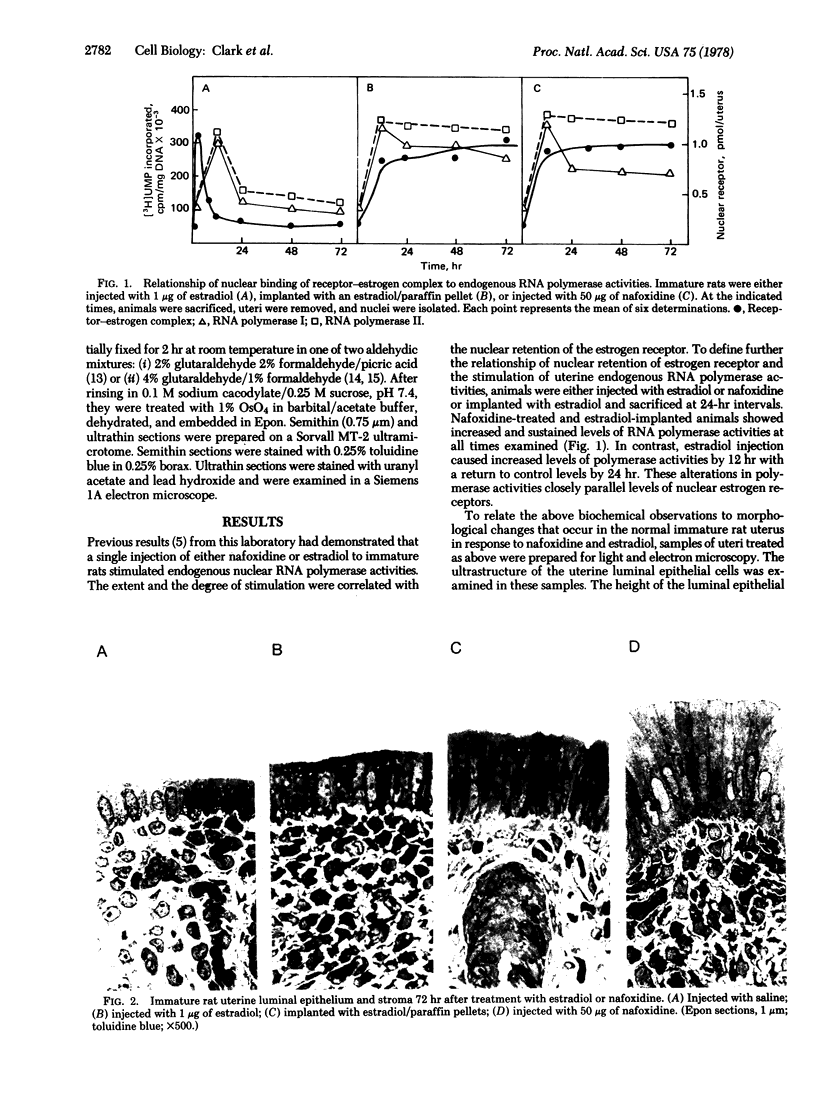
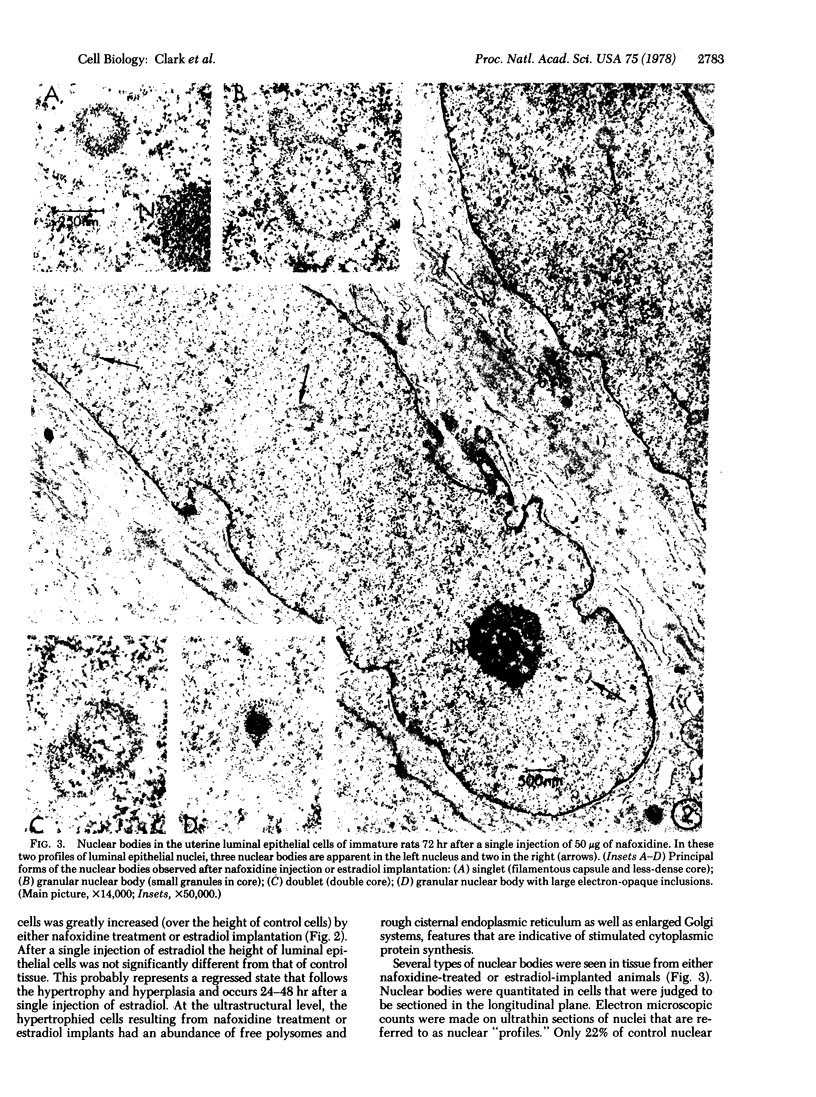
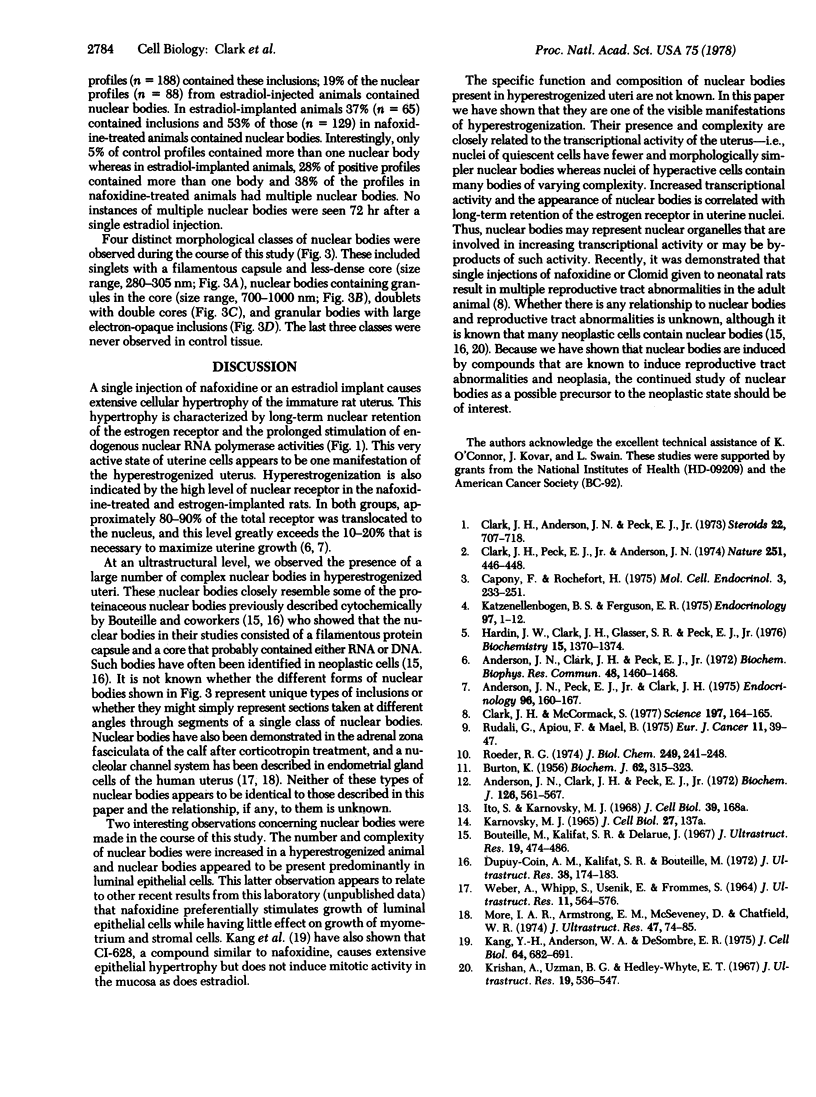
Images in this article
Selected References
These references are in PubMed. This may not be the complete list of references from this article.
- Anderson J. N., Clark J. H., Peck E. J., Jr The relationship between nuclear receptor-estrogen binding and uterotrophic responses. Biochem Biophys Res Commun. 1972 Sep 26;48(6):1460–1468. doi: 10.1016/0006-291x(72)90878-9. [DOI] [PubMed] [Google Scholar]
- Anderson J. N., Peck E. J., Jr, Clark J. H. Estrogen-induced uterine responses and growth: relationship to receptor estrogen binding by uterine nuclei. Endocrinology. 1975 Jan;96(1):160–167. doi: 10.1210/endo-96-1-160. [DOI] [PubMed] [Google Scholar]
- Anderson J., Clark J. H., Peck E. J., Jr Oestrogen and nuclear binding sites. Determination of specific sites by ( 3 H)oestradiol exchange. Biochem J. 1972 Feb;126(3):561–567. doi: 10.1042/bj1260561. [DOI] [PMC free article] [PubMed] [Google Scholar]
- BURTON K. A study of the conditions and mechanism of the diphenylamine reaction for the colorimetric estimation of deoxyribonucleic acid. Biochem J. 1956 Feb;62(2):315–323. doi: 10.1042/bj0620315. [DOI] [PMC free article] [PubMed] [Google Scholar]
- Bouteille M., Kalifat S. R., Delarue J. Ultrastructural variations of nuclear bodies in human diseases. J Ultrastruct Res. 1967 Aug 30;19(5):474–486. doi: 10.1016/s0022-5320(67)80074-1. [DOI] [PubMed] [Google Scholar]
- Capony F., Rochefort H. In vivo effect of anti-estrogens on the localisation and replenishment of estrogen receptor. Mol Cell Endocrinol. 1975 Sep;3(3):233–251. doi: 10.1016/0303-7207(75)90047-7. [DOI] [PubMed] [Google Scholar]
- Clark J. H., Anderson J. N., Peck E. J., Jr Estrogen receptor-anti-estrogen complex: atypical binding by uterine nuclei and effects on uterine growth. Steroids. 1973 Nov;22(5):707–718. doi: 10.1016/0039-128x(73)90118-9. [DOI] [PubMed] [Google Scholar]
- Clark J. H., McCormack S. Clomid or nafoxidine administered to neonatal rats causes reproductive tract abnormalities. Science. 1977 Jul 8;197(4299):164–165. doi: 10.1126/science.877546. [DOI] [PubMed] [Google Scholar]
- Clark J. H., Peck E. J., Jr, Anderson J. N. Oestrogen receptors and antagonism of steroid hormone action. Nature. 1974 Oct 4;251(5474):446–448. doi: 10.1038/251446a0. [DOI] [PubMed] [Google Scholar]
- Dupuy-Coin A. M., Kalifat S. R., Bouteille M. Nuclear bodies as proteinaceous structures containing ribonucleoproteins. J Ultrastruct Res. 1972 Jan;38(1):174–187. doi: 10.1016/s0022-5320(72)90091-3. [DOI] [PubMed] [Google Scholar]
- Hardin J. W., Clark J. H., Glasser S. R., Peck E. J., Jr RNA polymerase activity and uterine growth: Differential stimulation by estradiol, estriol, and nafoxidine. Biochemistry. 1976 Apr 6;15(7):1370–1374. doi: 10.1021/bi00652a003. [DOI] [PubMed] [Google Scholar]
- Kang Y. H., Anderson W. A., DeSombre E. R. Modulation of uterine morphology and growth by estradiol-17beta and an estrogen antagonist. J Cell Biol. 1975 Mar;64(3):682–691. doi: 10.1083/jcb.64.3.682. [DOI] [PMC free article] [PubMed] [Google Scholar]
- Katzenellenbogen B. S., Ferguson E. R. Antiestrogen action in the uterus: biological ineffectiveness of nuclear bound estradiol after antiestrogen. Endocrinology. 1975 Jul;97(1):1–12. doi: 10.1210/endo-97-1-1. [DOI] [PubMed] [Google Scholar]
- More I. A., Armstrong E. M., McSeveney D., Chatfield W. R. The morphogenesis and fate of the nucleolar channel system in the human endometrial glandular cell. J Ultrastruct Res. 1974 Apr;47(20):74–85. doi: 10.1016/s0022-5320(74)90027-6. [DOI] [PubMed] [Google Scholar]
- Roeder R. G. Multiple forms of deoxyribonucleic acid-dependent ribonucleic acid polymerase in Xenopus laevis. Isolation and partial characterization. J Biol Chem. 1974 Jan 10;249(1):241–248. [PubMed] [Google Scholar]
- Rudali G., Apiou F., Muel B. Mammary cancer produced in mice with estriol. Eur J Cancer. 1975 Jan;11(1):39–41. doi: 10.1016/0014-2964(75)90035-3. [DOI] [PubMed] [Google Scholar]
- WEBER A., WHIPP S., USENIK E., FROMMES S. STRUCTURAL CHANGES IN THE NUCLEAR BODY IN THE ADRENAL ZONA FASCICULATA OF THE CALF FOLLOWING THE ADMINISTRATION OF ACTH. J Ultrastruct Res. 1964 Dec;11:564–576. doi: 10.1016/s0022-5320(64)80082-4. [DOI] [PubMed] [Google Scholar]





